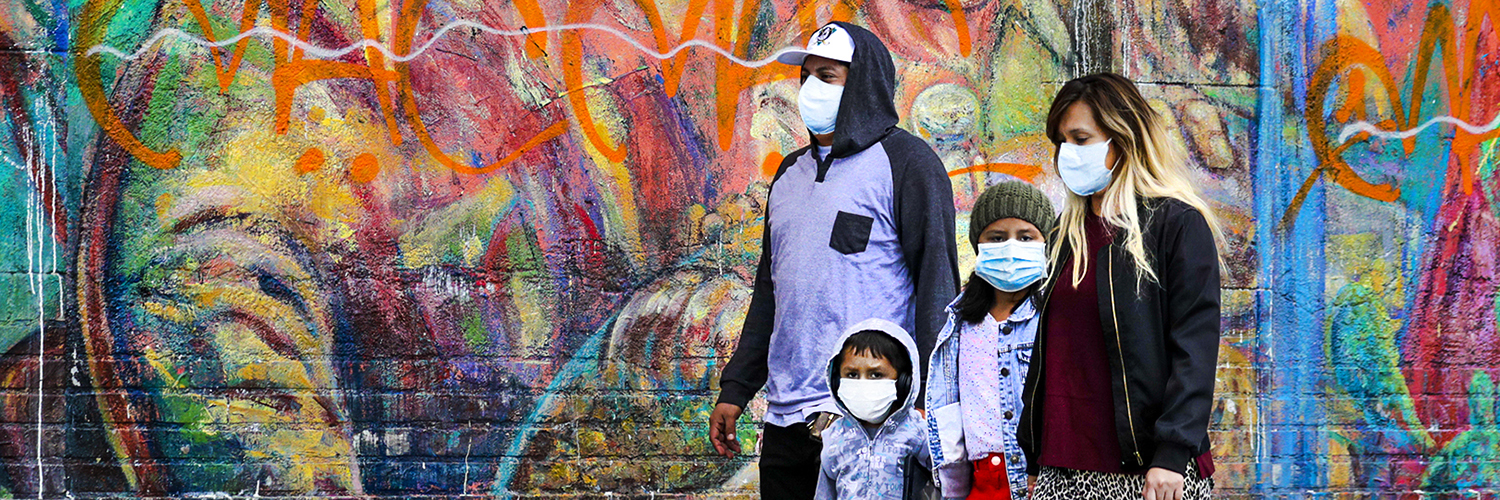
<p>A family in face masks walk down Soto Street on Saturday morning in Los Angeles. Life around Cesar E. Chavez Blvd. and Soto St. has slowed down as California officials extended stay-at-home orders into May and residents entered Easter weekend with unprecedented limits on their movements. Most of the people are adhering to the orders by mayor to wear masks while out running errands. (Irfan Khan / Los Angeles Times via Getty Images)</p>
The COVID-19 pandemic has prompted innovative responses from various sectors across America, from industrial companies rethinking supply chains to health care providers adopting new regulations to serve patients. The pandemic’s scale has also brought philanthropic innovation to the forefront, with organizations rallying to address urgent humanitarian needs, both in advance of and in conjunction with state and federal agencies.
Although philanthropy cannot replace an effective and assertive government response, it can enhance it, especially when the problem’s complexity requires multiple stakeholders working toward a common goal. In California and Washington, newly created public-private partnerships illustrate this type of joint innovation. The partnerships are intended to address the needs of groups affected by the pandemic, with private funds broadening the reach of state resources. If successful, these partnerships could provide a roadmap for other states looking for best practices to shape their own pandemic response.
How California and Washington are collaborating with philanthropy
In California, the new state-financed $75 million Disaster Relief Fund will partner with the privately funded California Immigrant Resilience Fund, which has already attracted $5.5 million in lead investments toward their $50 million goal. Together, the funds will provide financial assistance to families of undocumented immigrants who have been affected by COVID-19 and are ineligible for unemployment insurance benefits and disaster relief, including through the Coronavirus Aid, Relief, and Economic Security Act, because of their immigration status. Regional nonprofits with expertise and experience serving undocumented communities will disburse the funding.
Focusing on undocumented immigrants is especially important in California, where undocumented residents and their family members constitute about 10 percent of California’s workforce and pay more than $3 billion in state and local taxes every year. Many work in low-wage sectors hit hardest by the pandemic, from caregiving and hospitality to food service and landscaping.
National survey data from late March and early April found that Hispanic adults in families with noncitizens were reporting job and income losses at higher rates than other groups and that more than 4 in 10 Hispanic adults with children and a noncitizen family member in the household reported food insecurity in the past month. As of early May, a disproportionate share of deaths from COVID-19 were among Latinos, who make up the majority of California’s undocumented population.
California philanthropies are also supporting efforts to help immigrants understand the new public charge rule. Many lawfully present, eligible families are discouraged from applying for public benefits because they are afraid doing so will have negative immigration consequences.
In Washington State, a request has been submitted to the Centers for Medicare & Medicaid Services to establish a disaster relief fund as part of Medicaid, but it is still under review (PDF). As proposed, the fund intends to cover services such as quarantine isolation tents, disease screening centers, and shelters for people experiencing homelessness who test positive, which are not traditionally offered within Medicaid. In addition, private funds would be used to cover some of the costs.
If approved, Washington’s disaster relief fund would extend the reach of philanthropic dollars to the state’s approximately 1.6 million Medicaid beneficiaries. As job losses and decreased work hours cause incomes to fall, more residents are likely to become eligible for Medicaid services. For this reason, recent analyses have urged state and federal governments to maximize flexibility and ensure access to care for those eligible for health care safety net programs, which the proposed fund would do.
Challenges and opportunities in creating a successful philanthropic-government partnership
Philanthropy’s relationship with government generally falls into three categories: filling resource gaps, as in the California partnership; leveraging government resources, as in the Washington State proposal; and holding government accountable and advocating for better performance. These roles are not exclusive, and private funders who contribute to state COVID-19 funds may also expect governments to more effectively meet communities’ needs.
Even when philanthropies and governments plan to work together to meet an urgent need, the two sectors’ vastly different institutional goals and leadership interests make collaboration difficult. For philanthropies, limited understanding of public sector constraints, concern that such partnerships can threaten philanthropic independence, and the reality of divergent operating cultures all pose obstacles to effectively working with governments. These partnerships also can be perceived as obscuring the lines (PDF) of responsibility between government agencies and private institutions or as functioning as implicit endorsements of the privatization of public goods.
These difficulties notwithstanding, private funders have a growing interest in implementation-focused partnerships with agencies that make decisions about public policy and investment. Funders know partnerships have been proven to increase their work’s impact and influence institutional change. The disaster relief funds in California and Washington relate to this trend because they reflect private funders’ interests not only in contributing to governmental response to an immediate crisis but also in adapting how government programs operate and who they serve.
How the two states’ funds take shape will be worth watching over the long term, with particular attention paid to the sources of private donations, how the funds are administered, the role of private funders in this process, the evaluation of their effects, and whether other states follow suit.
Let’s build a future where everyone, everywhere has the opportunity and power to thrive
Urban is more determined than ever to partner with changemakers to unlock opportunities that give people across the country a fair shot at reaching their fullest potential. Invest in Urban to power this type of work.